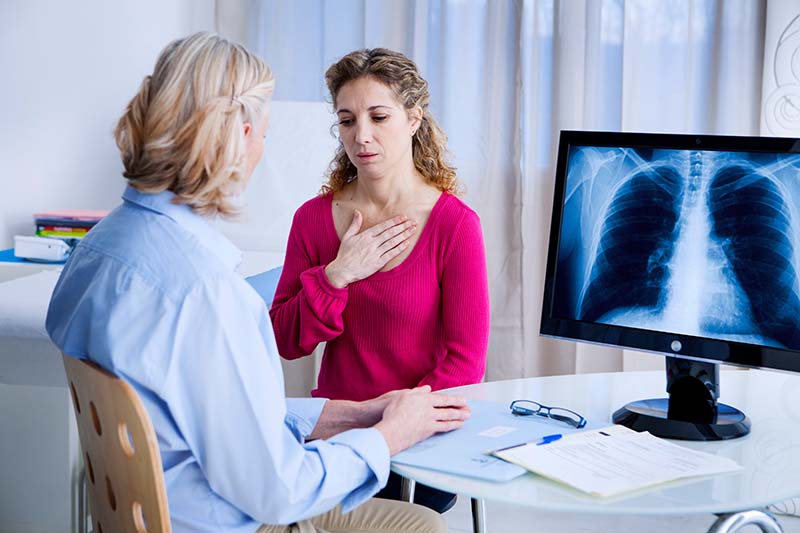
For decades, lung cancer rates have always been higher in men than in women mostly related to more men smoking than women. But in recent years the lung cancer rates in women have actually surpassed that of men. Research has found that lung cancer diagnoses have risen 84% in women over the past 43 years while dropping 36% in men and not just among women who have a history of smoking, but among non-smokers too. This has resulted in a lot of focus on what’s causing this rise of cases among women and how their treatment needs may be different from men.
What’s Causing An Increased Rate in Lung Cancer Diagnosis Among Women?
Although smoking is a major risk factor for both men and women, it seems that women’s bodies may react differently to the cancer-causing chemicals found in cigarettes. This has resulted in more lung cancer cases, especially among women ages 35-49. But it’s more than smoking. There’s been a rise in lung cancer cases among non-smoking women too.
These non-smoking women may be exposed to more second-hand smoke and environmental toxins. But there could also be a hormonal response and/or genetic factors that affect women differently than men. At this time, there are only theories with no definite answer as to why more women (namely non-smoking women) are being diagnosed with lung cancer.
Environmental Factors Related to Lung Cancer in Non-Smokers
Second-Hand Smoke Exposure
The chemicals left in the air from cigarette smoke are inhaled by others living in the same area. Over time this can build up and cause lung cancer in someone who doesn’t smoke. In addition to lung cancer, second-hand smoke is related to heart attacks and strokes in adult women.
Radon Gas
This toxin is naturally found in Georgia’s granite bedrocks and can exist in a home without showing any signs. This odorless, tasteless, and colorless gas causes more than 800 deaths per year in Georgia and is the second leading cause of cancer in the United States. Because it is undetectable without a proper test, it is recommended that all homeowners in Georgia get their homes tested for radon gas. Learn more about radon testing in Georgia here.
Related blog: What You Need to Know About Radon Gas and Lung Cancer
Chemical/Toxin Exposure
Some chemicals are known to cause lung cancer. If you work or live in an area where there are fumes or dust from uranium, arsenic, cadmium, chromium, nickel, asbestos and some petroleum products, you’re at a higher risk of having genetic mutations that can lead to lung cancer.
Are Lung Cancer Symptoms Different for Women?
Lung cancer symptoms tend not to vary much between men and women, and in its early stages, most patients don’t show any symptoms at all. Some of the most commonly seen symptoms of lung cancer in women include cough, shortness of breath, chest pain, and fatigue. Additionally, patients may experience any of the following as their cancer develops:
- Bloody sputum, or coughing up blood
- Inexplicable weight loss
- Hoarseness
- Decrease in or loss of appetite, nausea
- Bone pain
- Headache
It’s a good idea to get screened for lung cancer if you have a history of smoking or you currently smoke.
Is One Type of Cancer More Common in Women Than Another?
The most common type of lung cancer in all patients is non-small cell lung cancer, accounting for 85% of lung cancer cases. The three subtypes of non-small cell lung cancer include:
- Adenocarcinoma
- Squamous cell carcinoma
- Large cell carcinoma
Women are more commonly diagnosed with adenocarcinoma than the other types of non-small cell lung cancers.
How Do Lung Cancer Treatments Vary By Gender?
Lung cancer treatments aren’t as gender specific as they are specific to a genetic mutation that may be identified through bio-marker testing. Some genetic mutations seem to be more common in women:
- KRAS gene mutations can make lung cancer grow faster if exposed to estrogen and other hormones.
- GRPR receptors are more active in women, and estrogen exposure makes it even more active.
- EGFR is a protein that is often present in people with lung cancer. Mutations in the gene that produces EGFR are significantly more common in females than in males.
Related Blog: What to Expect from Lung Cancer Radiation Therapy
Survival Rates Among Women with Lung Cancer
According to one study, the 5-year survival rate in women with non-small cell lung cancer is higher than that of men. This means that more women survive five years after their initial diagnosis than men do. This study found that the overall 5-year survival rate in lung cancer patients was 23%, whereas the 5-year survival rate was 23% for men and 33% for women. The reason for women’s higher survival rate hasn’t been defined just yet. In general, however, women tend to be more likely to change their lifestyle habits after a lung cancer diagnosis. This can include not smoking or using other tobacco, exercise, and healthy eating habits.
Treating Lung Cancer Patients in Georgia
Leading edge lung cancer treatments, including the most advanced radiation therapy, are available to you close to your home in Georgia. Talk to your oncologist about all of the treatments that will be included in your lung cancer treatment plan and how your gender might affect your treatments and outcomes.




